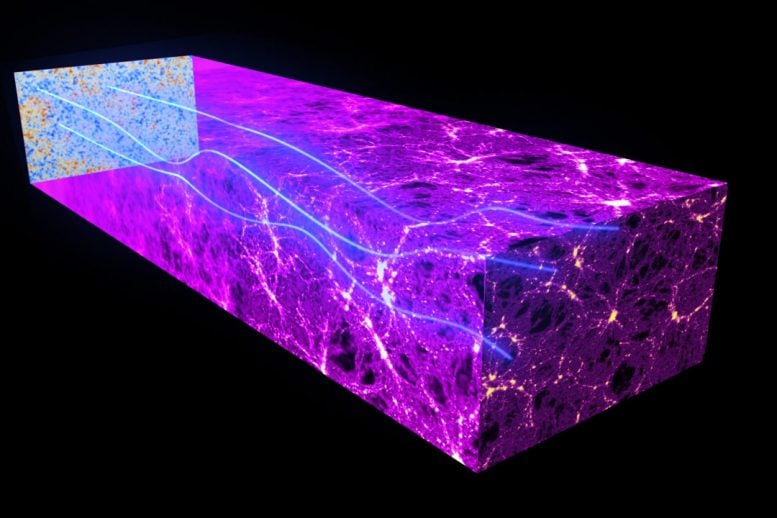
This illustration shows how photons in the Cosmic Microwave Background (CMB) are deflected by the gravitational lensing effect of massive cosmic structures as they travel across the Universe. Credit: ESA and the Planck Collaboration
Using data from the National Science Foundation’s South Pole Telescope and ESA’s Herschel Space Observatory, astronomers have made the first detection of a subtle twist in the Cosmic Microwave Background, paving the way towards revealing the first moments of the Universe’s existence.
Cosmologists have achieved a first detection of a long-sought component in the Cosmic Microwave Background (CMB). This component, known as B-mode polarization, is caused by gravitational lensing, the bending of light by massive structures as it travels across the Universe. The result is based on the combination of data from the South Pole Telescope and ESA’s Herschel Space Observatory. This detection is a milestone along the way to the possible discovery of another kind of B-mode signal in the polarized CMB – a signal produced by gravitational waves less than a second after the Universe began.
The Cosmic Microwave Background is the most ancient light that has traveled almost unimpeded across the Universe, and it contains a wealth of information about the origin and nature of the cosmos. During their journey, photons from the CMB have encountered a multitude of galaxies and galaxy clusters and have been deflected by these large concentrations of matter.
This phenomenon, known as gravitational lensing, imprints a subtle distortion on the pattern of the CMB that encodes details about the large-scale distribution of structure in the Universe. In recent years, cosmologists have detected the signature of gravitational lensing on the CMB temperature using data from ground-based and space-borne experiments, including the first all-sky image of this effect achieved using ESA’s Planck satellite.
A small portion of the CMB is polarized, and gravitational lensing also affects this part of the signal. In fact, the polarized CMB is an additional and even richer treasure trove than the unpolarized signal to use to explore the Universe’s past. Now a team of cosmologists studying the polarized CMB has detected in it the signature of gravitational lensing, opening new and exciting possibilities to study the distribution of matter across the cosmos. This result is also the first detection of the elusive second component of the CMB polarization – the long-sought B-modes.
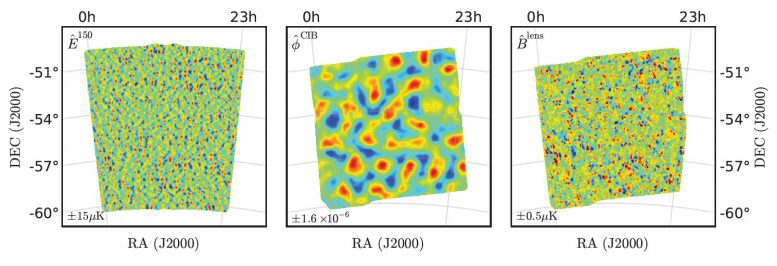
E-modes and B-modes in the CMB polarization (left and right panels, respectively) and the gravitational potential of the large-scale distribution of matter that is lensing the CMB (central panel). Credit: Image from D. Hanson, et al., 2013, Physical Review Letters
The study is based on the combination of data from SPTpol, the polarization-sensitive receiver on the National Science Foundation’s South Pole Telescope (SPT), and the SPIRE instrument on board ESA’s Herschel Space Observatory. The SPT is a ground-based telescope, located in Antarctica, to observe the CMB to very high angular resolution in a small patch of the southern sky.
“The CMB is partially polarized: this means that it carries additional directional information, like the light that can be observed using polarized glasses,” explains Joaquin Vieira from the California Institute of Technology in Pasadena and University of Illinois at Urbana-Champaign, USA. Vieira led the Herschel survey that enabled this result.
“The pattern we observe in polarized light can be split in two distinctive components: we call these E-modes and B-modes. In the case of CMB polarization, these two components carry very different and complementary information about both the early and the late Universe.”
The CMB is the glow from the early Universe, when it first became transparent to radiation, about 380,000 years after the Big Bang. There are fluctuations in both the temperature of the CMB and its polarization, which represent tiny differences in density and pressure at that epoch. The polarization of the CMB has a distinctive pattern of E- and B-modes that dates back to the early Universe. But this pattern, and in particular the intensity of the B-mode component, underwent substantial changes as the polarized CMB propagated across the Universe.
“When gravitational lensing distorts the polarized CMB photons, it transforms part of the E-modes into B-modes,” explains Vieira.
Only a small fraction of the CMB is polarized, so it is a very weak signal and extremely difficult to detect. The E-mode component of CMB polarization, which has a stronger intensity than the B-mode one, was first observed in 2002 with the ground-based Degree Angular Scale Interferometer (DASI), and with a variety of other experiments in the following years. The B-modes are an extremely weak signal and, until now, had remained undetected.
“In our study, we combined the polarized CMB observed by SPT with independent data from Herschel. This technique allowed us to finally spot the B-modes induced by gravitational lensing,” comments Vieira.
The cosmologists detected the B-mode signal due to gravitational lensing in the data from SPT. To make their detection more robust, they added complementary observations from Herschel to trace the large-scale distribution of galaxies that cause the lensing.
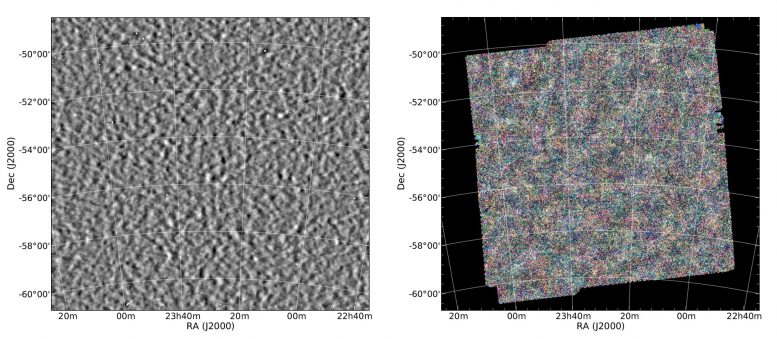
The Cosmic Microwave Background observed with SPT (left) and the Cosmic Infrared Background observed with Herschel (right). Credit: Image from G. Holder et al., 2013, The Astrophysical Journal Letters, 771, L16
“Herschel offers us a good data set to reconstruct the gravitational potential of the galaxies that are distorting the CMB,” says Vieira.
“Including the Herschel data in our analysis made the SPTpol data less sensitive to instrumental effects and was key to isolating the lensing-induced B-mode signal.”
With its wide spectral coverage ranging from far-infrared to sub-millimeter wavelengths, Herschel is sensitive to the Cosmic Infrared Background (CIB). In contrast to the CMB, which is the diffuse light from the early Universe, the CIB is a cumulative background, and arose with the formation of stars and galaxies, which started several hundreds of millions of years after the Big Bang.
Whilst stars shine primarily at ultraviolet wavelengths, over the entire age of the Universe roughly half of this energy has been absorbed by cosmic dust within galaxies; this cold dust reradiates starlight at longer, far-infrared wavelengths. For this reason, the CIB encapsulates the cosmic history of star formation.
Galaxies tend to group in galaxy clusters, which are embedded in dark matter halos, and these large concentrations of dark and normal matter are what cause the gravitational lensing of the CMB. For this reason, there is a very strong correlation between the gravitationally-lensed CMB and the CIB detected by Herschel, as the latter traces the lenses responsible for the deflection. By locating points in the sky where more (or fewer) galaxies are present, the extra information contained in the Herschel data allowed the team to see the gravitational lensing effect more clearly.
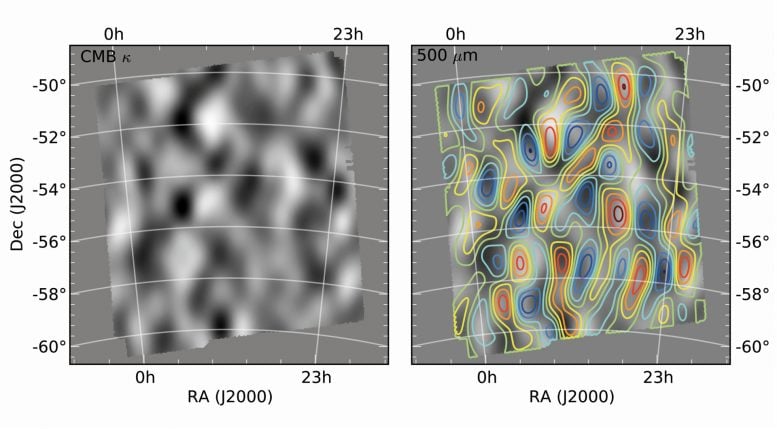
This image shows the density of the large-scale distribution of matter in the Universe as seen projected along the line of sight and estimated using two different types of data. Credit: Image from G. Holder et al., 2013, The Astrophysical Journal Letters, 771, L16
This first result opens a new era in the study of the gravitationally-lensed CMB. So far, cosmologists have successfully studied gravitational lensing on the CMB temperature, but this signal is subject to a large degree of intrinsic noise, and it will be extremely difficult to improve significantly on the best current results. Studying the effect of gravitational lensing in the polarized CMB, instead, is expected to provide a much cleaner probe of the underlying distribution of matter causing the lensing.
“Polarization holds the key to the future of gravitational lensing studies of the CMB,” comments Duncan Hanson from McGill University in Montréal, Canada, who is first author of the paper reporting the discovery.
“This field is in its early stages right now, but as we collect more and more data, we will be able to study the large-scale distribution of matter with ever greater precision.”
The study was based on observations with SPTpol together with Herschel data of a large patch of the sky, measuring 100 square degrees, that overlaps with the survey performed with SPTpol.
“It is great to see this ingenious use of Herschel data in achieving the first detection of B-modes in the CMB polarization, which are fluctuations at a level of one in about ten million,” comments Göran Pilbratt, Herschel Project Scientist at ESA.
“This work displays yet another use of the treasure trove of the available Herschel data,” he adds.
Apart from its application to gravitational lensing, the discovery of B-modes is a milestone because it proves that it is possible to detect such a signal. Worldwide, cosmologists are still searching for a different type of B-modes, those created by primordial gravitational waves, using experiments including SPT and Planck. Cosmologists believe that the Universe began with a very early phase of accelerated expansion known as inflation. During this very rapid phase, which boosted the size of the Universe exponentially, it is thought that gravitational waves were also generated.
“Gravitational waves are ripples in the fabric of space-time, and we think that those produced during inflation left an imprint in the B-mode component of the CMB polarization,” explains co-author Stephen Hoover from the Kavli Institute for Cosmological Physics at the University of Chicago, USA.
Finding such a signal would provide crucial information to study the very early Universe and inflation. Detection of B-modes induced by primordial gravitational waves, however, may prove even more complex as they are expected to have very different properties to those caused by gravitational lensing. Since primordial B-modes become apparent on much larger angular scales than those probed in this study, cosmologists will need to scan and analyze the signal on larger portions of the sky. Besides, cosmologists are still in the dark as to the amplitude and shape of the signal they are looking for, due to the many theoretical uncertainties that are still plaguing inflation.
“The fact that we were able to detect B-modes in the CMB polarization at all is a great experimental success. We’re all eager to find out whether this will be followed by the even more exciting discovery of primordial gravitational waves,” concludes Vieira.
References:
“Detection of B-Mode Polarization in the Cosmic Microwave Background with Data from the South Pole Telescope” by D. Hanson, S. Hoover, A. Crites, P. A. R. Ade, K. A. Aird, J. E. Austermann, J. A. Beall, A. N. Bender, B. A. Benson, L. E. Bleem, J. J. Bock, J. E. Carlstrom, C. L. Chang, H. C. Chiang, H-M. Cho, A. Conley, T. M. Crawford, T. de Haan, M. A. Dobbs, W. Everett, J. Gallicchio, J. Gao, E. M. George, N. W. Halverson, N. Harrington, J. W. Henning, G. C. Hilton, G. P. Holder, W. L. Holzapfel, J. D. Hrubes, N. Huang, J. Hubmayr, K. D. Irwin, R. Keisler, L. Knox, A. T. Lee, E. Leitch, D. Li, C. Liang, D. Luong-Van, G. Marsden, J. J. McMahon, J. Mehl, S. S. Meyer, L. Mocanu, T. E. Montroy, T. Natoli, J. P. Nibarger, V. Novosad, S. Padin, C. Pryke, C. L. Reichardt, J. E. Ruhl, B. R. Saliwanchik, J. T. Sayre, K. K. Schaffer, B. Schulz, G. Smecher, A. A. Stark, K. T. Story, C. Tucker, K. Vanderlinde, J. D. Vieira, M. P. Viero, G. Wang, V. Yefremenko, O. Zahn and M. Zemcov, (SPTpol Collaboration), 30 September 2013, Physical Review Letters.
DOI: 10.1103/PhysRevLett.111.141301
arXiv:1307.5830
“A CMB lensing mass map and its correlation with the cosmic infrared background” by G. P. Holder, M. P. Viero, O. Zahn, K. A. Aird, B. A. Benson, S. Bhattacharya, L. E. Bleem, J. Bock, M. Brodwin, J. E. Carlstrom, C. L. Chang, H-M. Cho, A. Conley, T. M. Crawford, A. T. Crites, T. de Haan, M. A. Dobbs, J. Dudley, E. M. George, N. W. Halverson, W. L. Holzapfel, S. Hoover, Z. Hou, J. D. Hrubes, R. Keisler, L. Knox, A. T. Lee, E. M. Leitch, M. Lueker, D. Luong-Van, G. Marsden, D. P. Marrone, J. J. McMahon, J. Mehl, S. S. Meyer, M. Millea, J. J. Mohr, T. E. Montroy, S. Padin, T. Plagge, C. Pryke, C. L. Reichardt, J. E. Ruhl, J. T. Sayre, K. K. Schaffer, B. Schulz, L. Shaw, E. Shirokoff, H. G. Spieler, Z. Staniszewski, A. A. Stark, K. T. Story, A. van Engelen, K. Vanderlinde, J. D. Vieira, R. Williamson and M. Zemcov, 19 June 2013, The Astrophysical Journal Letters.
DOI: 10.1088/2041-8205/771/1/L16
arXiv:1303.5048


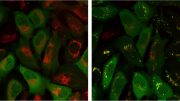
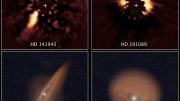


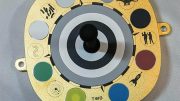

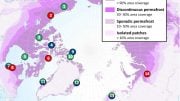
This along with other papers want to try to say that Protons move slower than light! which is also reported as being able to show the beginnings of our universe! so much for light travelling fast! it should be out of range of our visible reach long ago! when I read papers like this I feel that some people cannot accept the realism of infinity or acepting that what is!… Oh Well
Well said! What I take from the images presented, is that the distribution of light and matter in what they like to call “the early universe” is so evenly distributed that it proves beyond a shadow of a doubt that no ‘Big Bang’ ever took place, as one would expect to see some clear indication in the images that such a cataclysmic event took place at some point in space and time. NONE of the data so far presented by CMB images indicate any concentration or dispersion of radiation towards or away from any single point- destroying absolutely any impression that the universe was created from any singularity!
This is nothing more than a distraction exercise designed to keep everyone looking for what isn’t there rather than accepting the bloody obvious!!!
Gravitational ‘lensing’ is a classic phenomena observed by the prismatic split of LIGHT from far off galaxies by the intervening Dark Matter through gravitational waves. However CMB or CIB which are Cosmic Microwave Backround and Cosmic Infra Red Backround , were to come after attenuation of initial gamma rays, ultra-violet and light rays from Big Bang,by the Doppler effect.This article sees the ‘lensing’ of CMB also in the case of polarization effect. It goes to prove that initial enormous number of galaxies including the Dark Matter formed twisted the light from Big Bang through their gravitational waves. Gravitational waves started to appear only after clustering of Matter and Dark Matter formation in the Universe. Let us take the torch further to find the birth of E-M waves,Gravitational waves,Strong forces or color forces in their order and also to evaluate the all evading Dark Matter and Dark energy of the Universe.Thank You.